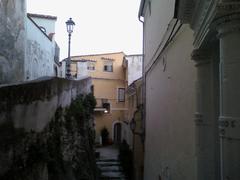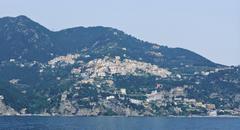Dragonea Vietri sul Mare: Visiting Hours, Tickets, and Historical Sites Guide
Date: 14/06/2025
Introduction
Tucked into the verdant hills above the Amalfi Coast, Dragonea is a tranquil hamlet of Vietri sul Mare, Italy, offering an immersive journey into medieval history, religious heritage, and an enduring tradition of ceramics. Often overlooked in favor of its coastal neighbors, Dragonea rewards visitors with picturesque landscapes, centuries-old churches, and a vibrant community spirit. This guide provides detailed information on Dragonea’s origins, cultural landmarks, visiting logistics, and practical tips to ensure a memorable experience.
For current visiting hours, tickets, guided tour options, and the latest updates, consult resources like the Portale Ceramica Vietri sul Mare, Visit Naples and Amalfi Coast Travel Tips, and the official Vietri sul Mare tourism site.
Table of Contents
- Early Origins and Settlement
- Medieval Development and Defensive Role
- Ceramics Tradition and Integration with Vietri sul Mare
- Agricultural Heritage and Rural Life
- Religious and Cultural Landmarks
- Festivals and Community Life
- Museums and Artisan Experiences
- Practical Visitor Information
- Travel Tips
- Frequently Asked Questions (FAQ)
- Conclusion
- References
Early Origins and Settlement
Dragonea’s roots trace back to the medieval era, though the wider area of Vietri sul Mare shows evidence of Etruscan and Roman activity. The name “Dragonea” may derive from the Latin “Draconaria,” possibly alluding to local legends or the winding shape of the valley (Antenati Italiani). Its strategic hilltop location facilitated agricultural development and trade, aided by proximity to ancient Roman roads.
Medieval Development and Defensive Role
During the Middle Ages, Dragonea, like many coastal villages in Campania, fortified itself to withstand Saracen raids and internal strife. The village’s clustered stone houses and narrow streets reflect this defensive past. Notable is the Torre di Dragonea, part of a network of towers built to spot and repel invaders (Life in Italy).
Religious structures such as the Church of San Giovanni Battista and the Church of Saints Peter and Paul became central to both spiritual life and community identity, enduring as gathering points and symbols of resilience.
Ceramics Tradition and Integration with Vietri sul Mare
From the 15th century onwards, Dragonea’s fortunes became closely tied to Vietri sul Mare’s rise as a ceramics capital. While primarily rural, Dragonea contributed raw materials and labor to the bustling ceramics workshops below. The local tradition of polychrome ceramics—seen in tiles, tableware, and church decorations—remains a defining feature of the area (Visit Naples and Amalfi Coast Travel Tips; Amalfi Coast Online Portal).
The Museo della Ceramica Vietrense in nearby Raito offers an in-depth look at centuries of local ceramics craftsmanship (official museum website).
Agricultural Heritage and Rural Life
Dragonea’s terraced hillsides are dotted with vineyards, olive groves, and citrus orchards. The production of wine, olive oil, and the famed Sfusato Amalfitano lemons has shaped the local economy and cuisine. Traditional farming methods and seasonal festivals continue to play a vital role in the village’s cultural rhythm.
Religious and Cultural Landmarks
Church of San Giovanni Battista
Dating back to the 10th century, this iconic duomo is noted for its pastel pink façade and majolica-tiled dome. Open daily from 9:00 AM–12:30 PM and 4:00 PM–7:00 PM (hours may vary during festivals). Entry is free; donations are welcome (official Vietri tourism site).
Church of Saints Peter and Paul
Among the oldest parishes in the province of Salerno, this hilltop church is open from 9:00 AM–12:30 PM and 3:30 PM–6:00 PM. Entrance is free, and guided tours can be arranged through the local tourist office (Portale Ceramica Vietri sul Mare).
Sanctuary of San Vincenzo Ferreri
A vital pilgrimage site and architectural landmark, restored after the 1980 earthquake and reopened in 2008. Open daily from 9:00 AM–6:00 PM, admission is free. Special events take place on the patron saint’s feast day, April 5th (Portale Ceramica Vietri sul Mare).
Festivals and Community Life
Dragonea’s calendar is rich with religious and folk festivals, especially the feast of San Vincenzo Ferreri in April and Saints Peter and Paul in June. These events feature processions, music, and communal meals, uniting the village’s six historic contrade (neighborhoods). Local legends—such as tales of dragons or miraculous occurrences—are woven into festival traditions, contributing to a strong sense of identity (Portale Ceramica Vietri sul Mare).
Museums and Artisan Experiences
Museo della Ceramica Vietrense
Located in Villa Guariglia, this museum showcases Vietri’s celebrated ceramic art. Open Tuesday–Sunday, 9:00 AM–3:00 PM; closed Mondays. Admission: €5 adults, €3 seniors/students, free for children under 12. Guided tours require advance booking (official museum website).
Artisan Workshops
Local studios in Dragonea and Vietri sul Mare offer hands-on ceramics workshops for all ages, allowing you to create your own piece under expert guidance (solosophie.com).
Practical Visitor Information
- Access: Dragonea is 2.5 km from Vietri sul Mare, reachable by a scenic walk, local bus (line 1), or car (parking is limited).
- Walking: The village’s narrow, cobblestone streets are best explored on foot; comfortable shoes are recommended.
- Accessibility: Major churches and the museum are wheelchair accessible with assistance.
- Dress Code: Modest attire is advisable when visiting religious sites.
- Best Time to Visit: June offers pleasant weather and fewer crowds (visititaly.eu).
- Accommodations: Options include B&Bs, boutique hotels, and agriturismi; book early in high season.
Travel Tips
- Combine Experiences: Pair your visit with a tour of Vietri’s historic center, ceramics shops, and nearby beaches.
- Festivals: Plan visits around religious or ceramics festivals for a deeper cultural experience.
- Photography: Don’t miss panoramic viewpoints and artistic alleyways for unique photo opportunities.
- Gastronomy: Sample local seafood, lemon specialties, and enjoy meals served on handmade ceramic tableware.
Frequently Asked Questions (FAQ)
Q: What are the main churches’ visiting hours?
A: Churches are generally open from morning to early evening, typically 9:00 AM–6:00 PM; see above for specific sites.
Q: Are tickets required to visit religious sites?
A: No, entry to churches and the sanctuary is free; donations are appreciated.
Q: How do I reach Dragonea?
A: Accessible by foot from Vietri sul Mare (2.5 km), local bus, or car (parking is limited).
Q: Are ceramics workshops suitable for children?
A: Yes, workshops are designed for participants of all ages.
Q: When are the major local festivals?
A: Feast of San Vincenzo Ferreri (April) and Saints Peter and Paul (late June).
Conclusion
Dragonea is a hidden gem on the Amalfi Coast, inviting visitors to experience a tapestry of history, spirituality, and artisanal tradition. From medieval architecture and storied churches to vibrant ceramics workshops and scenic vistas, the village offers something for every traveler. Immerse yourself in local festivals, explore artisan studios, and savor the flavors of this unique Italian destination.
For up-to-date information, consult the official Vietri sul Mare tourism website, the Museo della Ceramica Vietrense site, and trusted travel guides. Download the Audiala app for personalized recommendations and real-time updates.
References and Further Reading
- Antenati Italiani
- Portale Ceramica Vietri sul Mare
- Visit Naples and Amalfi Coast Travel Tips
- Amalfi Coast Online Portal
- The Road Reel
- Life in Italy
- Official Vietri sul Mare Tourism Site
- Museo della Ceramica Vietrense
- solosophie.com
- visititaly.eu



